Politics of the debt crisis

Rescuing colourful news metaphors: From diversionary politics to reformist agendas?
Denis Bright invites readers to take
note of the communication roles played by colourful news metaphors in
Australian politics.
The capacity of exotic news metaphors
in pictures, graphics and colourful texts to explain complex issues is
balanced by an awareness of their potential as agencies of political
persuasion.
Hypotehtical exclusive news scoop – from the Prime Minister’s flight deck.
Warning from Captain Abbott: Rough landing ahead at New Australia
Veer right after the debt
sign. Your Captain will take advantage of the head-winds generated by
our recent unpopular budget to make a difficult landing. Which policy
metaphor lever should I use, Crew to divert attention away from this
electorate’s real issues of concern?
sign. Your Captain will take advantage of the head-winds generated by
our recent unpopular budget to make a difficult landing. Which policy
metaphor lever should I use, Crew to divert attention away from this
electorate’s real issues of concern?
In the disciplined world of mainstream politics, leaders and their
advisers routinely make use of colourful news metaphors to simplify
domestic and international policy issues.
Spontaneous political metaphors from door-stop interviews have quite
determined links to thoughtful policy radar assessments of the issues of
the week.
Eyewitness news services soon want to be involved in the political game.
Readers of this hypothetical cartoon from a regional paper in New
Australia would have been familiar with the recent news feed about
Barnaby Joyce’s explanation of a self-perceived Australian public debt
problem:
“If you’re trying to turn the finances of our nation
around, there are going to be hard decisions that are made. And if we
don’t, we go broke,” Mr Joyce said on ABC radio.
“This is our first budget, I understand the concerns people have, I
fully understand them, but what is our alternative? We either accept
that we’ve got a debt problem and we’ve got to turn it around or we
basically we say ‘no, this is only a small melanoma on our arm, and if
we just wait long enough it’ll go away’. (From The Australian, 25 August
2014).
Political diversion strategies were successfully applied on the Prime
Minister’s hypothetical visit to the regional city of New Australia.
In the true genre of strong LNP leaders, metaphors were rattled off
about the choice of the correct flight path for hard-times now and in
the troubled times ahead for the global economy.
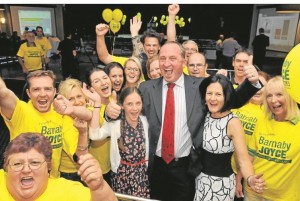
Winners are always grinners: On both sides of the political divide (Source: Namoi Valley Independent)
Reassuring commitments to market forces abounded as media releases
talked-up the bright future ahead if more legislative barriers to dry
economic agendas could be reduced.
Entrenched privilege was protected by the Prime Minister’s failure to
open up debate about the need for a simpler and fairer taxation system
that can deliver essential services and new infrastructure without
ongoing budget deficits.
The cheer squad for the Prime Minister in New Australia included many
local elites who have routinely benefited from the current taxation
loop-holes relating to negative gearing on rental properties and
payments of cash wages to casual employees.
A more exclusive circle included representatives of mining
entrepreneurs and other corporations from the mining sector. This sector
has a long tradition of siphoning off potential Australian Taxation
Office revenue through payments to commercial associates in overseas tax
havens.
Colourful news metaphors in mainstream political processes as diversionary political strategies
Populist communication strategies have worked well on both sides of
Australian politics. The election of Kevin Rudd in 2007 with the
assistance of the Your Rights at Work Campaign is the most recent example.
Historically, the federal ALP has scored well in developing news
metaphors with strong links to popular consensus-building policies.
Prime Minister John Curtin became an Australian and international icon as shown by this cover from Time Magazine on 24 April 1944 in recognition of his efforts are wartime leader.
With the guns silent, Ben Chifley won the 1946 elections to achieve
the federal ALP’s last majority in both houses of parliament from the
positive spin from domestic reform agendas and an active commitment to
peace and disarmament.
Prime Minister Chifley’s agenda was far less left wing than his news
metaphors suggested. Federal Labor faced a challenge from the support
base of the Communist Party in some heartland electorates and it was
appropriate to keep industrial unions onside with the ALP.
More recently, Opposition Leader, Bill Shorten, has gained impressive
traction in generating head-winds against the recent LNP budget. The
federal ALP has been up to ten points ahead of the government in
post-budget polling after the allocation of preferences.
Prime Minister Abbott has sought diversions in switching news
metaphors from financial austerity to foreign policy, defence and
terrorism concerns with some successes in recent polling.

Federal Labor: Marketing a successful reform agenda for Prime Minister Ben Chifley (image from News Corporation)
However, the summary of the opinion polls to 11 September 2014,
suggests the federal ALP still maintains a firm vote on the back of
additional support for the Greens which the current foreign crises have
generated.
Federal Labor must now go beyond its own successful opportunistic
rhetoric to link its protest messages to alternative policy frames which
offer some relief from financial austerity and constant involvement in
foreign conflicts.
One shaky LNP myth is the notion that the level of government in Australia is indeed excessive.
Tilting at LNP news metaphors about excessive levels of government in Australia
While still being identified with calls for financial austerity and
cut-backs in government spending, Prime Minister Abbott is not carried
away by the literal meaning of his own populist political communication.
Technical advisers have attended to shortfalls in the federal government’s own revenue base.
The federal budget revenue, as a percentage of gross domestic product
(GDP), is projected to increase to 25.5% by 2017-18 from 23.6% in Wayne
Swan’s last budget.
Without this increase, federal and state governments would be financially unsustainable.
In economic management, Prime Minister Abbott is not quite as ideologically driven as his government’s news metaphors suggest.
Synopsis of Budget Aggregates

Australian Budget 2014-15. Appendix A
This budget repair initiative by the LNP could provide the rationale
for similar major initiatives by federal Labor through tax reform
measures.
Such progressive initiatives could be justified by greater honesty
about Australia’s lean public sector when comparisons are made with
other OECD countries.
On the latest comparative OECD data for revenue as a percentage of
GDP for 2011, Australia is thirtieth on the list of thirty-four member
states.
Hardliners in the federal LNP would like to move Australia down the
list to compete with the neo-conservative countries at the bottom of the
barrel.
However, the LNP’s love of military commitments makes this literally impossible.
The news metaphor of the high tax Australian state
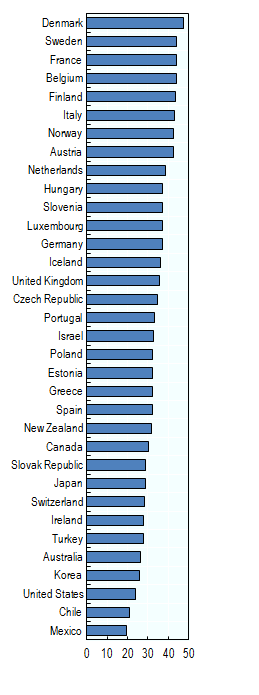
Can alternative news metaphors be constructed?
Overseas experience suggests that most corporately driven societies cannot hold the line against a growing wealth divide.
In more competitive societies, the wealth divide usually increases as
the remnants of social democracy are eroded by privatization as well as
cut-backs in services and industrial awards.
The LNP’s silence about the need for tax reform in Australia actually
protects wealthy families and corporations from making an appropriate
contribution to an improvement in the government’s revenue base.
The notion that everyone benefits from economic rationalist
strategies, as advocated by the LNP, is not evident in data from Oxfam.
None of the developed economies listed has achieved a more equitable
income distribution since 1990 with the exception of a slight
improvement in the USA, thanks to the presence of President Obama’s
domestic initiatives.
Ironically, the US remains one of the most unequal societies in the
developed world and the Abbott Government is committed to moving
Australia in this direction.
The return of the wealth divide
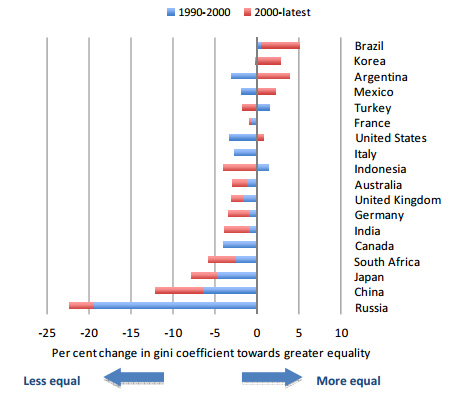
Oxfam 2012. Left Behind by the G20?
The challenge of the wealth divide demands more than a piecemeal
rejection of just some of the Abbott Government’s commitments to more
middle class welfare.
Federal Labor can construct defiant metaphors which are linked to
viable policy alternatives to the current near hegemony of dry economic
agendas by LNP federal and state governments.
The Murdoch press is of course no friend of the federal ALP. Even the biased headlines in The Australian could not hold the line against the depth of post-budget reactions from across the community.
Reporting the Address in Reply: With editorial metaphors embedded in the headlines
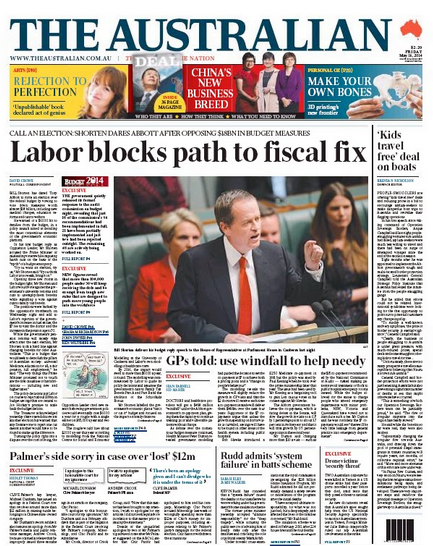
The Australian Online.16 May 2014
Perhaps the next conviction of a prominent wealthy tax evader or
errant corporation could be the trigger for a real debate about the need
for a simpler and fairer taxation system in Australia.
Addressing the profound levels of inappropriate taxation leakages
that benefit wealthy families, entrepreneurs and corporations is an
essential priority for all reasonable federal governments.
In every country town and regional districts, constituents are well
aware of the extent of tax leakages through payment of cash wages as
well as the conspicuous display of wealth from the misuse of family
trusts and family companies to achieve legal avenues for systematic tax
avoidance.
Laundering of money through overseas-based management funds and
diversion of company profits to offshore tax havens is less obvious. It
is well reported in news and current affairs programmes.
Cost estimates of the extent of these leakages should be part of the national public debate.
Progressive representatives on parliamentary committees have the
capacity to request appropriate estimates of tax leakages from the
Australian Tax Office, the Australian Crime Commission, the Australian
Transaction Reports and Analysis Centre (AUSTRAC) as well as other
relevant agencies.
As recommended by Taxpayers Australia, some new anti-avoidance
legislation is also required to manage rorts by some of Australia’s
wealthiest entrepreneurs, families and companies.
Anti-avoidance strategies are recommended by Taxpayers Australia:
- trading in franking credits (buying and selling shares just to
claim the franking credits without holding on to them long enough to
bear ownership risk) - personal services income (diverting income that is earned through your efforts into another entity with a lower tax rate)
- foreign income deferral (accumulating income in a country with lower tax rates)
- employee share schemes (receiving shares as remuneration and delaying the ‘taxing point’)
- company tax losses (companies cannot claim prior year losses
unless the majority of the ownership has not changed hands or unless the
same business activities are being carried on) - trust tax losses (trusts cannot claim prior year losses unless certain tests are passed)
- taxation of minors (punitive tax rates apply to minors under 18
years of age to prevent streaming income to children on lower tax rates
than the rest of the family).
Taxpayers Australia 2014
Associate Professor of Taxation Law at the Australian School of
Business at the University of NSW, Dale Boccabella, has made a number of
technical submissions to control the inappropriate leakage of taxation
revenue through the misuse of family trusts.
Speaking on The Drum, Dale Boccabella makes the following recommendations:
On the other hand, the generous tax treatment of
discretionary trusts (family trusts) is not included in the tax
expenditure statement – but there are good reasons why it should be. The
negative gearing loss on rental properties and share investments is not
included either. For 2012-13, the Commonwealth has around 280 tax
expenditures under the income tax, worth around $100 billion. This is
around 6 per cent of GDP. Direct expenditure of the Commonwealth for the
same period was around $360 billion, which is around 24 per cent of
GDP. (ABC.The Drum 12 March 2014).
If the current deficit problem is considered in this context, a different interpretation of The Age of Entitlement soon emerges.
Every billion that is leaked from the federal treasury through
inappropriate tax avoidance has a flow-on effect to the deficit problems
of the states and territories where tied grants are the key variable in
budget processes.
Opposition parties have nothing to lose by broadening the debate about the continued Age of Entitlement.
Playing the news metaphor game: The silence of most state and territory leaders
Failure to act on federal taxation reform has inevitable negative
effects on the deficit problems of the various states and territories.
The election of Prime Minister Abbott has not really assisted Premier Campbell Newman’s debt reduction strategies in Queensland.
Like the other states and territories, Queensland is increasingly dependent on the Commonwealth for its revenue base.
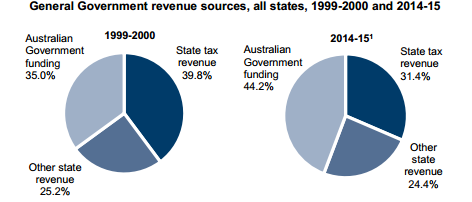
Queensland Budget 2014. Paper 2:6,107
The Queensland Budget Papers for 2014-15 show that 46 cents in every
dollar of state revenue (44.2 cents in all states and territories) are
derived from the Commonwealth through both GST revenue ($11.736 billion)
and specific grants ($11.313 billion).
Queensland is still the beneficiary of tied grants negotiated with
the former federal Labor Government which delivered an additional
windfall of almost $3 billion during 2013-14.
This financial glow will deteriorate as the financial austerity of
the Abbott Years takes its toll on future levels of grants to the states
and territories.
The news metaphors invariably project Queensland budget deficit as a
purely local problem to justify the austerity measures imposed by
Premier Campbell Newman.
In the absence of federal tax reform initiatives, the delivery of
essential services and infrastructure at state and territory levels will
become more challenging.
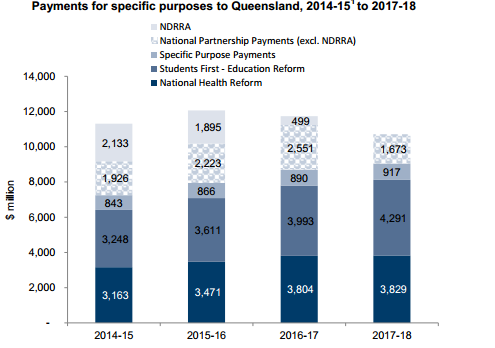
Queensland Budget 2014-15. Paper 2:6,121
Progressive representatives at both state and federal levels have
little to lose by talking up strategies for real solutions to budget
deficits.
Towards alternative news metaphors embedded in bold policy frames
In economic policies, progressive parliamentary representatives could
unite in constructing news metaphors about the value of a simpler and
fairer taxation system which protects the leadership role of the
Commonwealth in revenue collection.
The electorate can then balance the social costs of more financial
austerity with the value of more middle class welfare and tax anomalies
that protect wealthy families, rich entrepreneurs and many of
Australia’s leading financial corporations.
The politics of cynical diversion
The most potent policy frame for progressive representatives in state
and federal parliaments is of course the persuasive power of reasonable
alternatives.
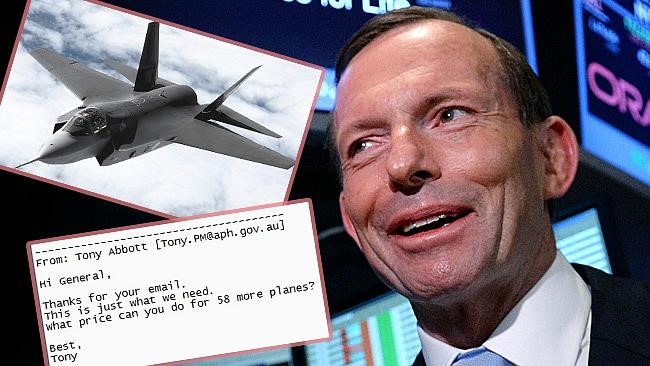
Source: Herald Sun
One place to start is the parliamentary finance committees at both
state and federal levels to expose the real injustices of current
taxation arrangements which make commitments to essential services a
luxury.
Professor John Quiggin of the Economics School at the University of
Queensland explained to a supportive audience at the Brisbane Workers’
Club on 26 August 2014 that commitment to taxation reform as a way out
of current deficit problems would be a real challenge.
Exotic news metaphors from the LNP to divert attention away from dry
economic and foreign policy agendas definitely exert powerful social
controls on political debate.
The sustainability of this spirit of protest will be vastly extended
if the federal ALP Policy Review Committee can use alternative metaphors
to support new pragmatic consensus-building policies that talk-up
Labor’s economic management credentials.
The sheer complexity and injustices of the current Australian
taxation system justifies more news metaphors which promote a real
reform agenda to end the diversionary politics of Prime Minister Abbott
at the end of his first term in office.
Denis Bright is a member of the
Media, Entertainment and Arts Alliance (MEAA). He is a registered
teacher with post-retirement studies in journalism, public policy and
international relations.

Denis Bright
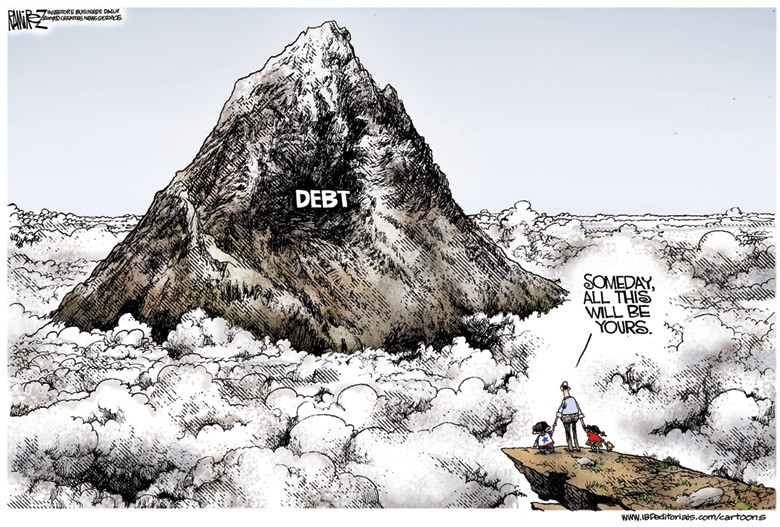

No comments:
Post a Comment